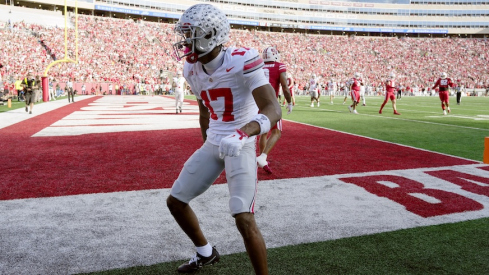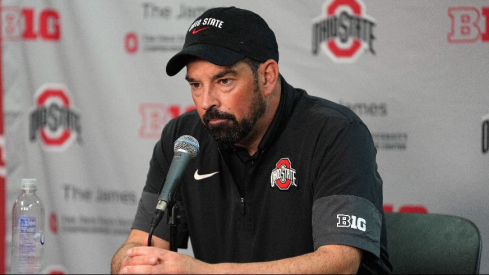
Against Iowa, the Ohio State defense turned in another middling performance. The Buckeyes allowed the Hawkeyes to dominate the first half. Iowa scored on its first three opportunities while controlling the clock, limiting the Ohio State offense to three possessions.
More troubling, the Buckeye defense exhibited many of the same schematic and personnel issues that have plagued Ohio State for over a year. Ohio State spent the first half unable to adjust or defend Iowa's simple, yet effective, strategy.
The Buckeye defense did stiffen in the second half, limiting the Hawkeye run game and, in so doing, slowing Iowa more generally. This demonstrated the defense's potential for better play, but left nagging issues unresolved. The Ohio State defense also received a major assist from an offense that controlled the third and fourth quarters.
Below I address Iowa's offensive game plan against Ohio State, where and how the Buckeye scheme and personnel could not adjust, and what Ohio State did differently in the second half.
the constraint is THE tHING
Iowa had a straightforward strategy that was effective because it worked together as a coherent whole and took advantage of Ohio State's schematic and personnel deficiencies. Iowa utilized two and three tight end sets (12 and 13 personnel). The Hawkeyes placed their two tight ends in a wing formation to the boundary, with one tight end and one receiver or two receivers to the field.
Iowa did so to gain a numbers' advantage. Ohio State aligns its defensive front to the field. That means that if the call is a 4-3 under, the coaches place the defense's numbers' strength to the field's wide side from a hash mark. The 1 technique, 5 technique, Mike and Sam linebackers go to the wide side, while the 3 technique, Viper and Will linebacker play to the boundary.
The Ohio State defense aligns in this manner even if the offense puts its formation strength to the boundary. In response, opposing offenses have regularly adopted the tactic of putting its numbers to the boundary. Iowa used its multiple tight ends to maximize its numeric advantage to the boundary side of the centerline (each player parallel to the football counts as 1/2 to each side).

From there, the Hawkeyes ran stretch, often to the boundary,

followed by bootleg flood routes to the field.
The Hawkeyes used no-huddle to prevent Ohio State from substituting or adjusting. The Hawkeyes would come to the line with their quarterback often using a check with me to determine which side to run. Iowa would then let the play clock run down before snapping.
While Iowa's scheme was simple it was effective because the Buckeyes could not stop the Hawkeye run game. Buckeye defenders accordingly over committed to the run, leaving them vulnerable to play action.
Matchup Mismatch
The numerical advantage Iowa gained had the additional benefit of creating matchup problems for the Buckeyes. Specifically, Iowa forced Ohio State's edge defenders to fill roles in which they were uncomfortable. Iowa's boundary stretch runs required Viper Noah Spence to hold the edge against Iowa's multiple tight ends. Spence had little help because of the Buckeyes' numbers disadvantage, but he struggled in this role. Spence was also asked to cover the boundary flats in pass coverage against Iowa's bootlegs, a role in which he is uncomfortable.
Iowa's boundary-heavy formation also resulted in the misalignment of certain defensive roles. Ohio State's boundary corner was required to provide force support and create a pile in response to being blocked by Iowa's tight ends. To the field, Sam linebacker Josh Perry effectively became a nickel back, aligning outside the tackle box to the wide side flat.
This trade-off making a corner a run defender and Perry a pass defnder was to Iowa's advantage, particularly once boundary corner Bradley Roby was ejected. Perry was particularly lost in his role. Even though he was responsible for wide side contain he often bit on play action away, providing Iowa easy throws off bootleg in the flat.

Tightening Down
The Ohio State defense did put forth a better second half performance. Just as the first half problems resulted from both personnel and schematic breakdowns, the second half improvement came in both areas.
The biggest component was squeezing down against Iowa's run game. The best way to stop outside zone is to get inside penetration that cuts off the play and prevents cutback lanes. Unfortunately, as Mike Vrabel colorfully stated, Iowa's offensive line "beat the shit out of the Buckeye defensive line in the first half. The left side of Iowa's offensive line was particularly effective.
That changed in the second half. Michael Bennett began controlling the line of scrimmage, forcing Iowa's tailbacks offline, thereby providing Ohio State defenders time to flow to the football before the Hawkeye ball carriers reached the second level.

By limiting the run game, Iowa was forced into must-pass situations where the underneath play action game was less effective, providing the Buckeyes the opportunity to get off the field.
The Old Switcheroo
Schematically the Buckeyes made subtle adjustments. The Buckeyes began slanting their defense line towards the multiple tight ends. In coverage the Buckeyes sought to take away Iowa's wide side flat throws. Ohio State continued to play cover 3, but used a strong side cloud rotation. Wide side corner Doran Grant came down to take away the underneath flat, with the Buckeyes three defensive backs rotating to the wide side to play the deep thirds.

This allowed Grant to jump several throws. Alternatively, the Buckeyes played cover 2 man under in pass situations, again seeking to eliminate underneath and medium routes.
Get with the program
Iowa's offensive coaching staff deserves credit. They devised a plan that maximized their strengths vis a vie Ohio State. They did not run at the Buckeye defense line and did not try to beat the Buckeyes with their wide receivers. They attacked the weak spot of the Buckeye defense, namely their linebackers in space.
And they did so by using the best assets an offense has, namely dictating the personnel and numbers a defense must match, and by making plays look alike to constrain a defense. The Buckeye defense was not prepared to respond to 13 personnel, nor to Iowa's run-heavy boundary looks. By not being prepared to play the run, the defense was vulnerable to play action.
Nonetheless, the Buckeye defensive players and coaches must better adjust to what an offense is presenting. In the first half the Buckeye defensive players often looked to have communication issues and to be confused in setting their alignment. The defensive coaching staff is unlikely to alter its philosophy and begin calling its formation strength to match the offense. But the Buckeyes must adjust how they approach such formations, because going back to last season teams have hurt the Buckeyes by running to the boundary.
This primary adjustment must come from the defensive back seven. The Buckeyes need to roll its safeties towards the tight end side, walking the boundary safety up as a force defender. The linebackers must also adjust towards the offense's strong side. Slanting towards the tight ends was a good start but the Buckeyes also need to employ run blitzes to have defenders shoot the gap and stop outside zone early.
The Buckeyes' personnel must also play better. Spence and Bennett have significant tasks against the boundary run game. Both are undersized but must hold the point of attack. On the opposite end, if Josh Perry is responsible for the wide side flat, he must maintain discipline against the pass. Getting caught in the wash away from the play does nothing to benefit the defense. Against a team using this approach the defensive staff should also consider using nickel Tyvis Powell, given what is being asked of the Sam linebacker.
The Buckeyes' ability to defend the boundary was also significantly compromised by the loss of Roby. Roby is not only a physical run defender but also the linchpin of the Ohio State pass defense. Armani Reeves twice failed to get sufficient zone depth, resulting in two Iowa touchdown's including Iowa's 78 yard touchdown in the third quarter. It is self-evident why the Buckeyes are loathe to play man coverage without Roby.
The Buckeyes should certainly not be surprised if Penn State uses a similar formula Saturday. Penn State utilizes several tight ends and have perhaps the best receiver in the Big Ten in Allen Robinson. Look for Penn State to similarly align their tight ends to the boundary with Robinson isolated to the wide field. Watch for Penn State to use tight end stick routes early and often as they seek to exploit OSU's edge players in the underneath flat.
The Buckeyes must better control the line of scrimmage. From there, the Ohio State defensive coaching staff needs to go back to using some of the stunting and twisting it employed against Northwestern to generate a consistent pass rush.

